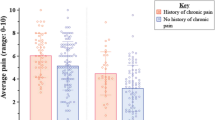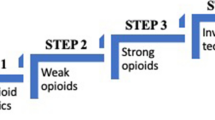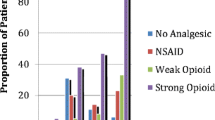Abstract
Purpose
Many patients with cancer seek care for pain in the emergency department (ED). Prospective research on cancer pain in this setting has historically been insufficient. We conducted this study to describe the reported pain among cancer patients presenting to the ED, how pain is managed, and how pain may be associated with clinical outcomes.
Methods
We conducted a multicenter cohort study on adult patients with active cancer presenting to 18 EDs in the USA. We reported pain scores, response to medication, and analgesic utilization. We estimated the associations between pain severity, medication utilization, and the following outcomes: 30-day mortality, 30-day hospital readmission, and ED disposition.
Results
The study population included 1075 participants. Those who received an opioid in the ED were more likely to be admitted to the hospital and were more likely to be readmitted within 30 days (OR 1.4 (95% CI: 1.11, 1.88) and OR 1.56 (95% CI: 1.17, 2.07)), respectively. Severe pain at ED presentation was associated with increased 30-day mortality (OR 2.30, 95% CI: 1.05, 5.02), though this risk was attenuated when adjusting for clinical factors (most notably functional status).
Conclusions
Patients with severe pain had a higher risk of mortality, which was attenuated when correcting for clinical characteristics. Those patients who required opioid analgesics in the ED were more likely to require admission and were more at risk of 30-day hospital readmission. Future efforts should focus on these at-risk groups, who may benefit from additional services including palliative care, hospice, or home-health services.
Similar content being viewed by others
Data availability
Not applicable.
References
Barbera L, Taylor C, Dudgeon D (2010) Why do patients with cancer visit the emergency department near the end of life? Cmaj. 182(6):563–568. https://doi.org/10.1503/cmaj.091187
Scarborough BM, Smith CB (2018) Optimal pain management for patients with cancer in the modern era. CA Cancer J Clin 68(3):182–196. https://doi.org/10.3322/caac.21453
van den Beuken-van Everdingen MH, Hochstenbach LM, Joosten EA, Tjan-Heijnen VC, Janssen DJ (2016) Update on prevalence of pain in patients with cancer: systematic review and meta-analysis. J Pain Symptom Manage 51(6):1070–90.e9. https://doi.org/10.1016/j.jpainsymman.2015.12.340
Stockler MR, Wilcken NR (2012) Why is management of cancer pain still a problem? J Clin Oncol United States 30:1907–1908
Cleeland CS, Gonin R, Hatfield AK, Edmonson JH, Blum RH, Stewart JA, Pandya KJ (1994) Pain and its treatment in outpatients with metastatic cancer. N Engl J Med 330(9):592–596. https://doi.org/10.1056/nejm199403033300902
Todd KH, Ducharme J, Choiniere M, Crandall CS, Fosnocht DE, Homel P, Tanabe P, PEMI Study Group (2007) Pain in the emergency department: results of the pain and emergency medicine initiative (PEMI) multicenter study. J Pain 8(6):460–466. https://doi.org/10.1016/j.jpain.2006.12.005
Donovan E, Ranney ML, Reid AM, Baird J, Green TC. Chronic pain in the emergency department. R I Med J (2013). 2017;100(2):25–9
Persson J (2016) Pain management in the emergency department—still a long way to go? Scand J Pain 13:144–145. https://doi.org/10.1016/j.sjpain.2016.09.007
Marcus BS, Venkat A (2015) Ethical pain management in the emergency department: the canary in the coal mine. Pain Manag 5(4):251–260. https://doi.org/10.2217/pmt.15.18
Fosnocht DE, Swanson ER, Barton ED (2005) Changing attitudes about pain and pain control in emergency medicine. Emerg Med Clin North Am 23(2):297–306. https://doi.org/10.1016/j.emc.2004.12.003
Pollack CV Jr, Viscusi ER (2015) Improving acute pain management in emergency medicine. Hosp Pract (1995) 43(1):36–45. https://doi.org/10.1080/21548331.2015.1000794
Lee P, Le Saux M, Siegel R, Goyal M, Chen C, Ma Y et al (2019) Racial and ethnic disparities in the management of acute pain in US emergency departments: meta-analysis and systematic review. Am J Emerg Med 37(9):1770–1777. https://doi.org/10.1016/j.ajem.2019.06.014
Tamayo-Sarver JH, Hinze SW, Cydulka RK, Baker DW (2003) Racial and ethnic disparities in emergency department analgesic prescription. Am J Public Health 93(12):2067–2073. https://doi.org/10.2105/ajph.93.12.2067
Controlled prescription drug abuse at epidemic level. J Pain Palliat Care Pharmacother. 2006;20(2):61–4
Brady KT, McCauley JL, Back SE (2016) Prescription opioid misuse, abuse, and treatment in the United States: an update. Am J Psychiatry 173(1):18–26. https://doi.org/10.1176/appi.ajp.2015.15020262
Paice JA (2018) Cancer pain management and the opioid crisis in America: how to preserve hard-earned gains in improving the quality of cancer pain management. Cancer. 124(12):2491–2497. https://doi.org/10.1002/cncr.31303
Yanni LM, McKinney-Ketchum JL, Harrington SB, Huynh C, Amin Bs S, Matsuyama R et al (2010) Preparation, confidence, and attitudes about chronic noncancer pain in graduate medical education. J Grad Med Educ 2(2):260–268. https://doi.org/10.4300/jgme-d-10-00006.1
Breuer B, Fleishman SB, Cruciani RA, Portenoy RK (2011) Medical oncologists’ attitudes and practice in cancer pain management: a national survey. J Clin Oncol 29(36):4769–4775. https://doi.org/10.1200/jco.2011.35.0561
Krauss BS, Calligaris L, Green SM, Barbi E (2016) Current concepts in management of pain in children in the emergency department. Lancet. 387(10013):83–92. https://doi.org/10.1016/s0140-6736(14)61686-x
Gleason LJ, Escue ED, Hogan TM (2018) Older adult emergency department pain management strategies. Clin Geriatr Med 34(3):491–504. https://doi.org/10.1016/j.cger.2018.04.009
Wedmore I, Young S, Franklin J (2015) Emergency department evaluation and management of foot and ankle pain. Emerg Med Clin North Am 33(2):363–396. https://doi.org/10.1016/j.emc.2014.12.008
Lash RS, Bell JF, Reed SC, Poghosyan H, Rodgers J, Kim KK, Bold RJ, Joseph JG (2017) A systematic review of emergency department use among cancer patients. Cancer Nurs 40(2):135–144. https://doi.org/10.1097/ncc.0000000000000360
Caterino JM, Adler D, Durham DD, Yeung SJ, Hudson MF, Bastani A et al (2019) Analysis of diagnoses, symptoms, medications, and admissions among patients with cancer presenting to emergency departments. JAMA Netw Open 2(3):e190979. https://doi.org/10.1001/jamanetworkopen.2019.0979
Brown J, Grudzen C, Kyriacou DN, Obermeyer Z, Quest T, Rivera D, Stone S, Wright J, Shelburne N (2016) The emergency care of patients with cancer: setting the research agenda. Ann Emerg Med 68(6):706–711. https://doi.org/10.1016/j.annemergmed.2016.01.021
Richards CT, Gisondi MA, Chang CH, Courtney DM, Engel KG, Emanuel L, Quest T (2011) Palliative care symptom assessment for patients with cancer in the emergency department: validation of the screen for palliative and end-of-life care needs in the emergency department instrument. J Palliat Med 14(6):757–764. https://doi.org/10.1089/jpm.2010.0456
von Elm E, Altman DG, Egger M, Pocock SJ, Gotzsche PC, Vandenbroucke JP (2008) The Strengthening the Reporting of Observational Studies in Epidemiology (STROBE) statement: guidelines for reporting observational studies. J Clin Epidemiol 61(4):344–349. https://doi.org/10.1016/j.jclinepi.2007.11.008
Harris PA, Taylor R, Thielke R, Payne J, Gonzalez N, Conde JG (2009) Research electronic data capture (REDCap)—a metadata-driven methodology and workflow process for providing translational research informatics support. J Biomed Inform 42(2):377–381. https://doi.org/10.1016/j.jbi.2008.08.010
Woo A, Lechner B, Fu T, Wong CS, Chiu N, Lam H, Pulenzas N, Soliman H, DeAngelis C, Chow E (2015) Cut points for mild, moderate, and severe pain among cancer and non-cancer patients: a literature review. Ann Palliat Med 4(4):176–183. https://doi.org/10.3978/j.issn.2224-5820.2015.09.04
Chang AK, Bijur PE, Esses D, Barnaby DP, Baer J (2017) Effect of a single dose of oral opioid and nonopioid analgesics on acute extremity pain in the emergency department: a randomized clinical trial. Jama. 318(17):1661–1667. https://doi.org/10.1001/jama.2017.16190
Patel PM, Goodman LF, Knepel SA, Miller CC, Azimi A, Phillips G, Gustin JL, Hartman A (2017) Evaluation of emergency department management of opioid-tolerant cancer patients with acute pain. J Pain Symptom Manag 54(4):501–507. https://doi.org/10.1016/j.jpainsymman.2017.07.013
Fortner BV, Okon TA, Portenoy RK (2002) A survey of pain-related hospitalizations, emergency department visits, and physician office visits reported by cancer patients with and without history of breakthrough pain. J Pain 3(1):38–44
Zaza C, Baine N (2002) Cancer pain and psychosocial factors: a critical review of the literature. J Pain Symptom Manag 24(5):526–542. https://doi.org/10.1016/s0885-3924(02)00497-9
Clark D (1999) ‘Total pain’, disciplinary power and the body in the work of Cicely Saunders, 1958–1967. Soc Sci Med 49(6):727–736. https://doi.org/10.1016/s0277-9536(99)00098-2
van den Beuken-van Everdingen MH, de Rijke JM, Kessels AG, Schouten HC, van Kleef M, Patijn J (2007) Prevalence of pain in patients with cancer: a systematic review of the past 40 years. Ann Oncol 18(9):1437–1449. https://doi.org/10.1093/annonc/mdm056
Greco MT, Roberto A, Corli O, Deandrea S, Bandieri E, Cavuto S, Apolone G (2014) Quality of cancer pain management: an update of a systematic review of undertreatment of patients with cancer. J Clin Oncol 32(36):4149–4154. https://doi.org/10.1200/jco.2014.56.0383
Kwon JH (2014) Overcoming barriers in cancer pain management. J Clin Oncol 32(16):1727–1733. https://doi.org/10.1200/jco.2013.52.4827
Rhiner MI, von Gunten CF (2010) Cancer breakthrough pain in the presence of cancer-related chronic pain: fact versus perceptions of health-care providers and patients. J Support Oncol 8(6):232–238
Calcaterra S, Glanz J, Binswanger IA (2013) National trends in pharmaceutical opioid related overdose deaths compared to other substance related overdose deaths: 1999–2009. Drug Alcohol Depend 131(3):263–270. https://doi.org/10.1016/j.drugalcdep.2012.11.018
Alford DP, Carney BL, Brett B, Parish SJ, Jackson AH (2016) Improving residents’ safe opioid prescribing for chronic pain using an objective structured clinical examination. J Grad Med Educ 8(3):390–397. https://doi.org/10.4300/jgme-d-15-00273.1
Ferrell BR, Temel JS, Temin S, Alesi ER, Balboni TA, Basch EM, Firn JI, Paice JA, Peppercorn JM, Phillips T, Stovall EL, Zimmermann C, Smith TJ (2017) Integration of palliative care into standard oncology care: American Society of Clinical Oncology clinical practice guideline update. J Clin Oncol 35(1):96–112. https://doi.org/10.1200/jco.2016.70.1474
Massie MJ, Holland JC (1992) The cancer patient with pain: psychiatric complications and their management. J Pain Symptom Manag 7(2):99–109. https://doi.org/10.1016/0885-3924(92)90121-w
Green CR, Hart-Johnson T, Loeffler DR (2011) Cancer-related chronic pain: examining quality of life in diverse cancer survivors. Cancer. 117(9):1994–2003. https://doi.org/10.1002/cncr.25761
Acknowledgments
The Comprehensive Oncologic Emergencies Research Network (CONCERN) Network supported this study with scientific review and suggestions on the study design and conduct. Additional information about CONCERN is available at https://epi.grants.cancer.gov/concern/. Nonniekaye Shelburne, MS, CRNP, AOCN, and the Epidemiology and Genomics Research Program within the National Cancer Institute’s Division of Cancer Control and Population Science, Bethesda, Maryland, assisted with study design, data management, and ongoing support of the research network. We thank the study participants, research staff, and medical centers who have provided data for this study.
Author information
Authors and Affiliations
Corresponding author
Ethics declarations
Conflict of interest
Dr. Baugh has worked as a consultant and advisory board member for Janssen Pharmaceuticals, Nabriva Therapeutics, Salix Pharmaceuticals, and Vapotherm; has previously received research funding from Janssen Pharmaceuticals and Boehringer Ingelheim; and has served as an advisory board member and as a paid speaker for Roche Diagnostics. Dr. Yeung is the principal investigator of an investigator-initiated clinical trial supported by DepoMed and a retrospective clinical study supported by Bristol-Myers Squibb through ARISTA-USA (BMS/Pfizer American Thrombosis Investigator Initiated Research Program). Dr. Yeung participated in an advisory panel for Celgene. Dr. Henning receives research support from Baxter and provides consulting services to CytoVale.
Ethics approval
This study was approved by all participating institutional review boards.
Consent to participate
All patients provided written consent and signed a HIPPA waiver prior to participation.
Code availability
Not applicable.
Additional information
Publisher’s note
Springer Nature remains neutral with regard to jurisdictional claims in published maps and institutional affiliations.
Rights and permissions
About this article
Cite this article
Coyne, C.J., Reyes-Gibby, C.C., Durham, D.D. et al. Cancer pain management in the emergency department: a multicenter prospective observational trial of the Comprehensive Oncologic Emergencies Research Network (CONCERN). Support Care Cancer 29, 4543–4553 (2021). https://doi.org/10.1007/s00520-021-05987-3
Received:
Accepted:
Published:
Issue Date:
DOI: https://doi.org/10.1007/s00520-021-05987-3




